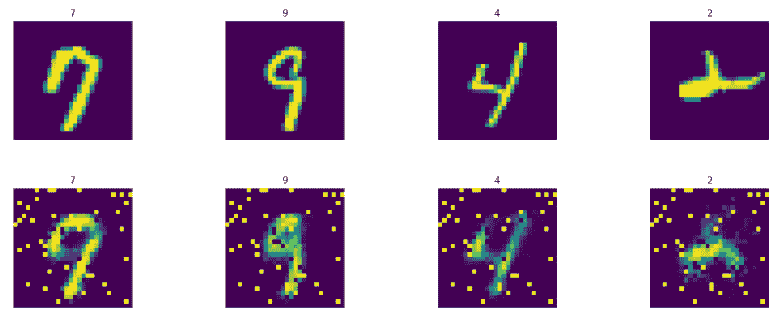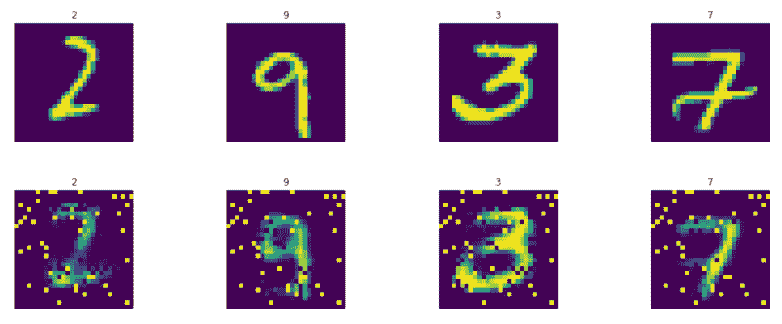# TensorFlow 中的栈式自编码器
在 TensorFlow 中构建栈式自编码器模型的步骤如下:
1. 首先,定义超参数如下:
```py
learning_rate = 0.001
n_epochs = 20
batch_size = 100
n_batches = int(mnist.train.num_examples/batch_size)
```
1. 定义输入(即特征)和输出(即目标)的数量。输出数量与输入数量相同:
```py
# number of pixels in the MNIST image as number of inputs
n_inputs = 784
n_outputs = n_inputs
```
1. 定义输入和输出图像的占位符:
```py
x = tf.placeholder(dtype=tf.float32, name="x", shape=[None, n_inputs])
y = tf.placeholder(dtype=tf.float32, name="y", shape=[None, n_outputs])
```
1. 添加编码器和解码器层的神经元数量为`[512,256,256,512]`:
```py
# number of hidden layers
n_layers = 2
# neurons in each hidden layer
n_neurons = [512,256]
# add number of decoder layers:
n_neurons.extend(list(reversed(n_neurons)))
n_layers = n_layers * 2
```
1. 定义`w`和`b`参数:
```py
w=[]
b=[]
for i in range(n_layers):
w.append(tf.Variable(tf.random_normal([n_inputs \
if i==0 else n_neurons[i-1],n_neurons[i]]),
name="w_{0:04d}".format(i)
)
)
b.append(tf.Variable(tf.zeros([n_neurons[i]]),
name="b_{0:04d}".format(i)
)
)
w.append(tf.Variable(tf.random_normal([n_neurons[n_layers-1] \
if n_layers > 0 else n_inputs,n_outputs]),
name="w_out"
)
)
b.append(tf.Variable(tf.zeros([n_outputs]),name="b_out"))
```
1. 构建网络并为每个层使用 sigmoid 激活函数:
```py
# x is input layer
layer = x
# add hidden layers
for i in range(n_layers):
layer = tf.nn.sigmoid(tf.matmul(layer, w[i]) + b[i])
# add output layer
layer = tf.nn.sigmoid(tf.matmul(layer, w[n_layers]) + b[n_layers])
model = layer
```
1. 使用`mean_squared_error`定义`loss`函数,使用`AdamOptimizer`定义`optimizer`函数:
```py
mse = tf.losses.mean_squared_error
loss = mse(predictions=model, labels=y)
optimizer = tf.train.AdamOptimizer(learning_rate=learning_rate)
optimizer = optimizer.minimize(loss)
```
1. 训练模型并预测`train`和`test`集的图像:
```py
with tf.Session() as tfs:
tf.global_variables_initializer().run()
for epoch in range(n_epochs):
epoch_loss = 0.0
for batch in range(n_batches):
X_batch, _ = mnist.train.next_batch(batch_size)
feed_dict={x: X_batch,y: X_batch}
_,batch_loss = tfs.run([optimizer,loss], feed_dict)
epoch_loss += batch_loss
if (epoch%10==9) or (epoch==0):
average_loss = epoch_loss / n_batches
print('epoch: {0:04d} loss = {1:0.6f}'
.format(epoch,average_loss))
# predict images using trained autoencoder model
Y_train_pred = tfs.run(model, feed_dict={x: train_images})
Y_test_pred = tfs.run(model, feed_dict={x: test_images})
```
1. 我们看到以下输出,因为损失在 20 个周期后显着减少:
```py
epoch: 0000 loss = 0.156696
epoch: 0009 loss = 0.091367
epoch: 0019 loss = 0.078550
```
1. 现在模型已经过训练,让我们显示训练模型中的预测图像。我们写了一个辅助函数`display_images`来帮助我们显示图像:
```py
import random
# Function to display the images and labels
# images should be in NHW or NHWC format
def display_images(images, labels, count=0, one_hot=False):
# if number of images to display is not provided, then display all the images
if (count==0):
count = images.shape[0]
idx_list = random.sample(range(len(labels)),count)
for i in range(count):
plt.subplot(4, 4, i+1)
plt.title(labels[i])
plt.imshow(images[i])
plt.axis('off')
plt.tight_layout()
plt.show()
```
使用此函数,我们首先显示训练集中的四个图像和自编码器预测的图像。
第一行表示实际图像,第二行表示生成的图像:

生成的图像有一点点噪音,可以通过更多训练和超参数调整来消除。现在预测训练集图像并不神奇,因为我们在这些图像上训练了自编码器,因此它知道它们。让我们看一下预测测试集图像的结果。 第一行表示实际图像,第二行表示生成的图像:

哇!经过训练的自编码器能够生成相同的数字,只有从 768 中学到的 256 个特征。生成的图像中的噪声可以通过超参数调整和更多训练来改善。
- TensorFlow 101
- 什么是 TensorFlow?
- TensorFlow 核心
- 代码预热 - Hello TensorFlow
- 张量
- 常量
- 操作
- 占位符
- 从 Python 对象创建张量
- 变量
- 从库函数生成的张量
- 使用相同的值填充张量元素
- 用序列填充张量元素
- 使用随机分布填充张量元素
- 使用tf.get_variable()获取变量
- 数据流图或计算图
- 执行顺序和延迟加载
- 跨计算设备执行图 - CPU 和 GPU
- 将图节点放置在特定的计算设备上
- 简单放置
- 动态展示位置
- 软放置
- GPU 内存处理
- 多个图
- TensorBoard
- TensorBoard 最小的例子
- TensorBoard 详情
- 总结
- TensorFlow 的高级库
- TF Estimator - 以前的 TF 学习
- TF Slim
- TFLearn
- 创建 TFLearn 层
- TFLearn 核心层
- TFLearn 卷积层
- TFLearn 循环层
- TFLearn 正则化层
- TFLearn 嵌入层
- TFLearn 合并层
- TFLearn 估计层
- 创建 TFLearn 模型
- TFLearn 模型的类型
- 训练 TFLearn 模型
- 使用 TFLearn 模型
- PrettyTensor
- Sonnet
- 总结
- Keras 101
- 安装 Keras
- Keras 中的神经网络模型
- 在 Keras 建立模型的工作流程
- 创建 Keras 模型
- 用于创建 Keras 模型的顺序 API
- 用于创建 Keras 模型的函数式 API
- Keras 层
- Keras 核心层
- Keras 卷积层
- Keras 池化层
- Keras 本地连接层
- Keras 循环层
- Keras 嵌入层
- Keras 合并层
- Keras 高级激活层
- Keras 正则化层
- Keras 噪音层
- 将层添加到 Keras 模型
- 用于将层添加到 Keras 模型的顺序 API
- 用于向 Keras 模型添加层的函数式 API
- 编译 Keras 模型
- 训练 Keras 模型
- 使用 Keras 模型进行预测
- Keras 的附加模块
- MNIST 数据集的 Keras 序列模型示例
- 总结
- 使用 TensorFlow 进行经典机器学习
- 简单的线性回归
- 数据准备
- 构建一个简单的回归模型
- 定义输入,参数和其他变量
- 定义模型
- 定义损失函数
- 定义优化器函数
- 训练模型
- 使用训练的模型进行预测
- 多元回归
- 正则化回归
- 套索正则化
- 岭正则化
- ElasticNet 正则化
- 使用逻辑回归进行分类
- 二分类的逻辑回归
- 多类分类的逻辑回归
- 二分类
- 多类分类
- 总结
- 使用 TensorFlow 和 Keras 的神经网络和 MLP
- 感知机
- 多层感知机
- 用于图像分类的 MLP
- 用于 MNIST 分类的基于 TensorFlow 的 MLP
- 用于 MNIST 分类的基于 Keras 的 MLP
- 用于 MNIST 分类的基于 TFLearn 的 MLP
- 使用 TensorFlow,Keras 和 TFLearn 的 MLP 总结
- 用于时间序列回归的 MLP
- 总结
- 使用 TensorFlow 和 Keras 的 RNN
- 简单循环神经网络
- RNN 变种
- LSTM 网络
- GRU 网络
- TensorFlow RNN
- TensorFlow RNN 单元类
- TensorFlow RNN 模型构建类
- TensorFlow RNN 单元包装器类
- 适用于 RNN 的 Keras
- RNN 的应用领域
- 用于 MNIST 数据的 Keras 中的 RNN
- 总结
- 使用 TensorFlow 和 Keras 的时间序列数据的 RNN
- 航空公司乘客数据集
- 加载 airpass 数据集
- 可视化 airpass 数据集
- 使用 TensorFlow RNN 模型预处理数据集
- TensorFlow 中的简单 RNN
- TensorFlow 中的 LSTM
- TensorFlow 中的 GRU
- 使用 Keras RNN 模型预处理数据集
- 使用 Keras 的简单 RNN
- 使用 Keras 的 LSTM
- 使用 Keras 的 GRU
- 总结
- 使用 TensorFlow 和 Keras 的文本数据的 RNN
- 词向量表示
- 为 word2vec 模型准备数据
- 加载和准备 PTB 数据集
- 加载和准备 text8 数据集
- 准备小验证集
- 使用 TensorFlow 的 skip-gram 模型
- 使用 t-SNE 可视化单词嵌入
- keras 的 skip-gram 模型
- 使用 TensorFlow 和 Keras 中的 RNN 模型生成文本
- TensorFlow 中的 LSTM 文本生成
- Keras 中的 LSTM 文本生成
- 总结
- 使用 TensorFlow 和 Keras 的 CNN
- 理解卷积
- 了解池化
- CNN 架构模式 - LeNet
- 用于 MNIST 数据的 LeNet
- 使用 TensorFlow 的用于 MNIST 的 LeNet CNN
- 使用 Keras 的用于 MNIST 的 LeNet CNN
- 用于 CIFAR10 数据的 LeNet
- 使用 TensorFlow 的用于 CIFAR10 的 ConvNets
- 使用 Keras 的用于 CIFAR10 的 ConvNets
- 总结
- 使用 TensorFlow 和 Keras 的自编码器
- 自编码器类型
- TensorFlow 中的栈式自编码器
- Keras 中的栈式自编码器
- TensorFlow 中的去噪自编码器
- Keras 中的去噪自编码器
- TensorFlow 中的变分自编码器
- Keras 中的变分自编码器
- 总结
- TF 服务:生产中的 TensorFlow 模型
- 在 TensorFlow 中保存和恢复模型
- 使用保护程序类保存和恢复所有图变量
- 使用保护程序类保存和恢复所选变量
- 保存和恢复 Keras 模型
- TensorFlow 服务
- 安装 TF 服务
- 保存 TF 服务的模型
- 提供 TF 服务模型
- 在 Docker 容器中提供 TF 服务
- 安装 Docker
- 为 TF 服务构建 Docker 镜像
- 在 Docker 容器中提供模型
- Kubernetes 中的 TensorFlow 服务
- 安装 Kubernetes
- 将 Docker 镜像上传到 dockerhub
- 在 Kubernetes 部署
- 总结
- 迁移学习和预训练模型
- ImageNet 数据集
- 再训练或微调模型
- COCO 动物数据集和预处理图像
- TensorFlow 中的 VGG16
- 使用 TensorFlow 中预训练的 VGG16 进行图像分类
- TensorFlow 中的图像预处理,用于预训练的 VGG16
- 使用 TensorFlow 中的再训练的 VGG16 进行图像分类
- Keras 的 VGG16
- 使用 Keras 中预训练的 VGG16 进行图像分类
- 使用 Keras 中再训练的 VGG16 进行图像分类
- TensorFlow 中的 Inception v3
- 使用 TensorFlow 中的 Inception v3 进行图像分类
- 使用 TensorFlow 中的再训练的 Inception v3 进行图像分类
- 总结
- 深度强化学习
- OpenAI Gym 101
- 将简单的策略应用于 cartpole 游戏
- 强化学习 101
- Q 函数(在模型不可用时学习优化)
- RL 算法的探索与开发
- V 函数(模型可用时学习优化)
- 强化学习技巧
- 强化学习的朴素神经网络策略
- 实现 Q-Learning
- Q-Learning 的初始化和离散化
- 使用 Q-Table 进行 Q-Learning
- Q-Network 或深 Q 网络(DQN)的 Q-Learning
- 总结
- 生成性对抗网络
- 生成性对抗网络 101
- 建立和训练 GAN 的最佳实践
- 使用 TensorFlow 的简单的 GAN
- 使用 Keras 的简单的 GAN
- 使用 TensorFlow 和 Keras 的深度卷积 GAN
- 总结
- 使用 TensorFlow 集群的分布式模型
- 分布式执行策略
- TensorFlow 集群
- 定义集群规范
- 创建服务器实例
- 定义服务器和设备之间的参数和操作
- 定义并训练图以进行异步更新
- 定义并训练图以进行同步更新
- 总结
- 移动和嵌入式平台上的 TensorFlow 模型
- 移动平台上的 TensorFlow
- Android 应用中的 TF Mobile
- Android 上的 TF Mobile 演示
- iOS 应用中的 TF Mobile
- iOS 上的 TF Mobile 演示
- TensorFlow Lite
- Android 上的 TF Lite 演示
- iOS 上的 TF Lite 演示
- 总结
- R 中的 TensorFlow 和 Keras
- 在 R 中安装 TensorFlow 和 Keras 软件包
- R 中的 TF 核心 API
- R 中的 TF 估计器 API
- R 中的 Keras API
- R 中的 TensorBoard
- R 中的 tfruns 包
- 总结
- 调试 TensorFlow 模型
- 使用tf.Session.run()获取张量值
- 使用tf.Print()打印张量值
- 用tf.Assert()断言条件
- 使用 TensorFlow 调试器(tfdbg)进行调试
- 总结
- 张量处理单元
